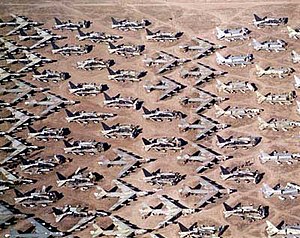Several times, I drove past a place I have wanted to see. Time was always my enemy, and another time it was the weather. This year, Peggy and I had the perfect day, and the timing was right. We were driving from Bisbee to Tucson on Interstate-Ten when an information sign cited the Pima Air and Space Museum. Without thinking or asking her if she was interested, I pulled the Death Star Avalon off the I-10 at exit 267. The rest was easy. We followed the signs to the museum entrance.
I was not attracted to a building filled with old airplanes as much as I was to taking a tour of the United States Air Force’s surplus storage facility at Davis -Monthan Air Base. The airbase is immediately adjacent to the museum. We parked and spoke to a volunteer who was directing people to various attractions. He told us that tour tickets of the airbase were available inside the museum. The next tour was an hour and a half away, so we bought entrance into the museum, and the airbase.
The first plane we saw after passing the gate into the museum hall was a full-scale replica of the Wright Flier hanging overhead. The plane impressed me as being much larger than I had imagined. I have seen ultra-light planes that are smaller. I always envisioned something a bit larger than a hang glider.
The first room was loaded with older planes hanging from the ceiling and more parked on the floor. Many of these were from the thirties, and I had never seen them in real-life, only pictures. I gawked and took pictures.
We passed into the next room and I almost fainted. There in front of me stood a SR 71 Blackbird. Until a few years ago, when it was retired from service, this plane was the most confidential in the fleet. The history of the plane is now leaking out in anecdotal accounts on the internet. After the Russians shot down Gary Powers in the original U-2 spy plane, the US needed another way to see what our enemies were doing. This plane was the answer. It flew higher, and faster, than any plane on earth. No one tells what top speed it is capable of, but the stories mention 2500 mph. The stories also mention pilots who out ran missiles fired to destroy them.
In the same room with the SR 71, there were a couple of WWII seaplanes. I remember these from newsreels about the war that I saw in the movies as a kid. Again, I was amazed at the size of these things.
It was time to leave for the tour. We still had not seen the airfield outside loaded with B52’s, C5A’s and every kind of big plane ever used by the Military. That will be a reason for returning.
Because we were entering a military base, the tour leader called our names and matched our picture ID to the names on his list. There were about forty people on this tour. The bus was air-conditioned and comfortable. Our tour guide introduced himself as a retired Air Force Major who flew an F105 during Viet Nam. His used the call name “Cappy.”
Cappy took us through the gates and down a special avenue cleared for tour buses. The scene that unfolded amazed me. The estimated value of the surplus aircraft in storage here is thirty billion dollars. There are row after row of airplanes of every type; attack, fighter, radar, bombers, transports, etc. They go on for miles. All of them are neatly parked, and packaged for long- term storage. Many of the planes are reserved for future deployment. They cannibalize another bunch for parts to keep the current fleet operational. The facility also acts as a parts depot for planes from foreign countries. I heard a statistic that for every dollar of cost spent to operate this facility the Air Force gets ten dollars in return. That is not bad for a government operation. Maybe the Air Force should run the Post Office.
Major Cappy told stories about every plane we passed. His knowledge of the aircraft was credible. The tour lasted an hour, but felt like fifteen minutes. I want to go back and see the remainder of the museum soon.
This slideshow requires JavaScript.
Filed under: Government, Memories, Travel, Uncategorized | Tagged: Air Museum, Airplanes, AMARG, B52, Bisbee, Blackbird, C5A, Davis-Monthan, F105, PIMA, SR71, Tucson, War Planes, Wilbur & Orville Wright | 1 Comment »

 Notice the swept back wings and the mosquito-like appearance. This plane easily avoids detection by radar and the naked eye too. This plane, by the way, is the only transparency in the Obama administration.
Notice the swept back wings and the mosquito-like appearance. This plane easily avoids detection by radar and the naked eye too. This plane, by the way, is the only transparency in the Obama administration.


